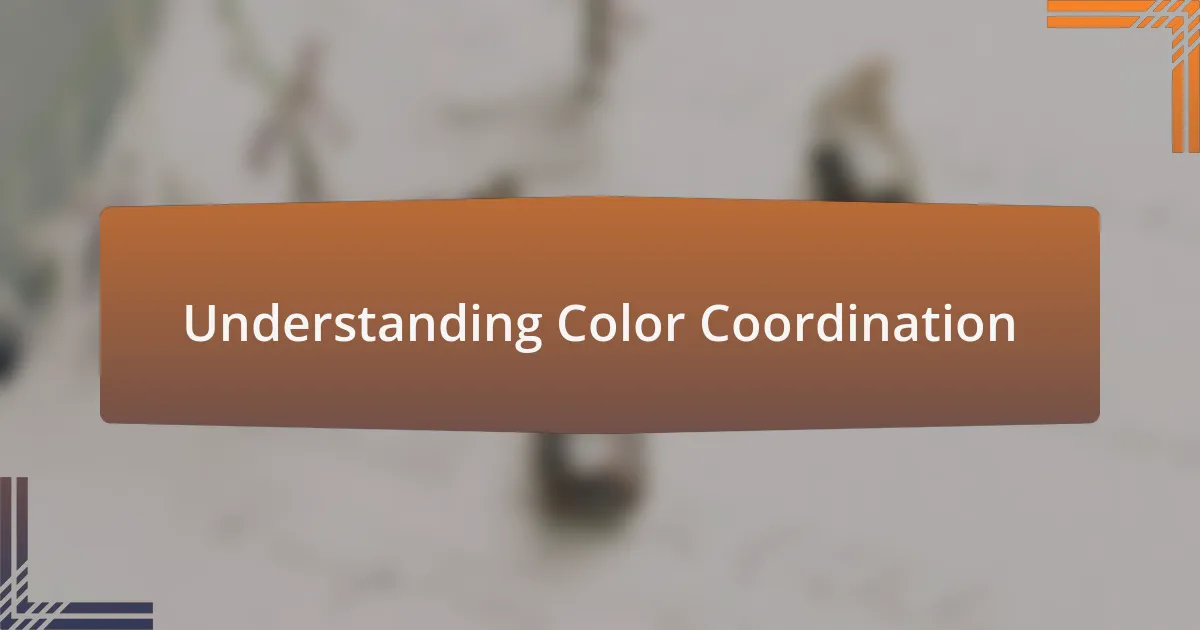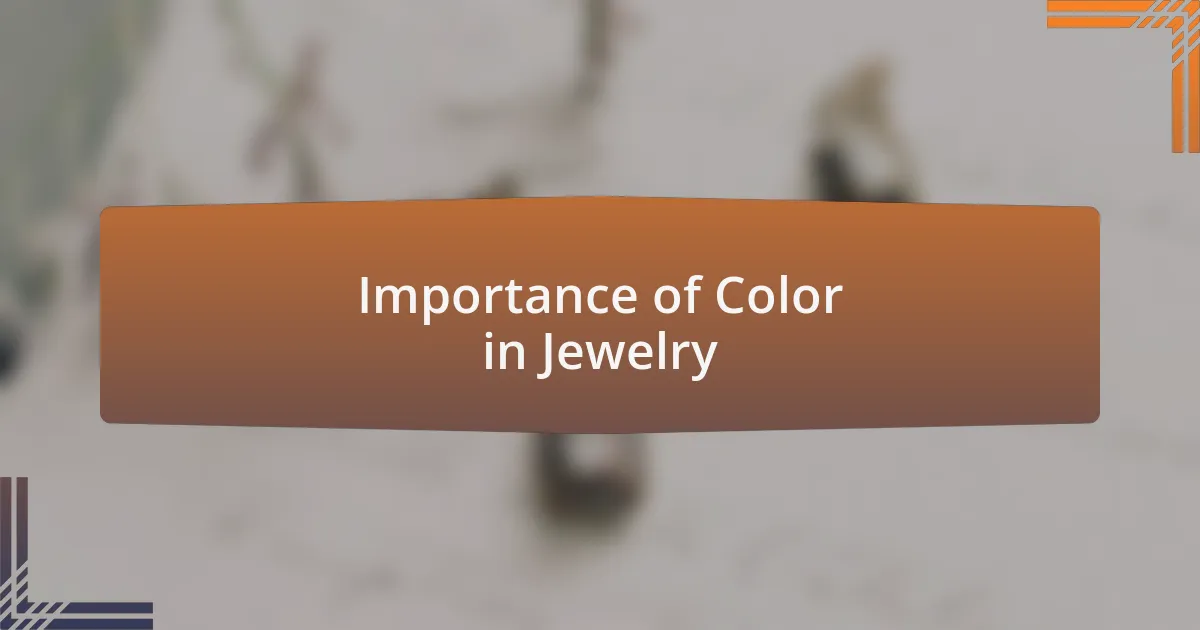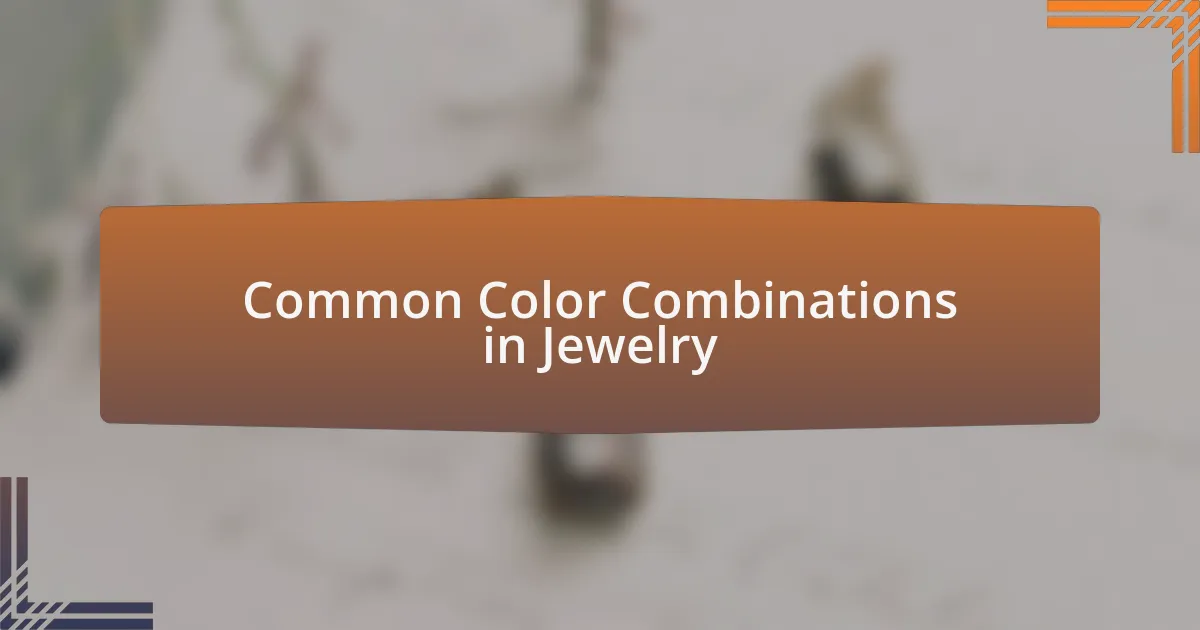Key takeaways:
- Color coordination in jewelry goes beyond matching hues; it reflects personality and creates harmony.
- Complementary colors and analogous hues enhance visual impact and can define moods.
- Common color combinations, such as blue and gold or purple and silver, can elevate an outfit’s sophistication.
- Practical tips include using the color wheel, layering different shades, and incorporating neutrals for balance.

Understanding Color Coordination
Color coordination in jewelry is not merely about matching hues; it’s about creating a harmonious relationship between the colors that reflect our personality and intention. I remember wearing a simple white dress paired with a bold turquoise necklace; it wasn’t a typical combination, but the striking contrast made me feel vibrant and confident. This experience taught me that sometimes, breaking the rules can yield stunning results.
When I think about how different colors evoke various emotions, I can’t help but wonder: Have you ever noticed how a pair of emerald green earrings can bring tranquility to an outfit? It’s fascinating how color psychology plays into our choices in jewelry. I often find myself gravitating towards warmer tones, like rose gold, during the autumn months; they seem to resonate with the cozy feelings of the season.
As I learned more about the color wheel, I found that complementary colors—those situated opposite each other—create a dynamic visual interest. Imagine wearing a coral bracelet alongside denim blue attire; that pop of color can make any outfit stand out effortlessly. Each piece you choose tells a story, and understanding color coordination allows you to control the narrative beautifully.

Importance of Color in Jewelry
When it comes to jewelry, color isn’t just an aesthetic choice; it carries immense significance. For instance, I vividly recall attending a wedding where the bride’s sapphire necklace added a regal touch to her classic gown. The rich blue not only made her stand out but also conveyed elegance and romance. This experience made me realize how color can enhance not only the piece of jewelry but also the entire atmosphere of an occasion.
Color can also reflect personal identity and mood. I often find myself choosing specific shades to evoke certain feelings. For example, when I wear a pair of sunny yellow earrings, I can’t help but smile; the brightness instantly uplifts my spirits. Have you ever noticed how the color you wear can influence how you feel about yourself? It’s curious how something as simple as a hue can alter our perception and even the perceptions others have of us.
Furthermore, the importance of harmony should never be underestimated. I once received a mixed-metal bracelet that incorporated silver and gold, which at first seemed like a clash. However, when I wore it with an outfit that echoed both tones, the combination felt surprisingly cohesive. This taught me that color coordination opens up limitless possibilities, allowing you to express your individuality while still maintaining balance.

Basic Color Theory for Jewelry
Understanding basic color theory can be a game changer when it comes to selecting and coordinating jewelry. For instance, I’ve always been drawn to complementary colors, those hues that sit opposite each other on the color wheel. The first time I paired an emerald green pendant with a bold red blouse, I noticed how each color seemed to enhance the vibrancy of the other, creating a striking visual impact that turned heads.
Analogous colors, or those that sit next to each other on the wheel, can create harmony in your jewelry choices. I remember layering a soft pink necklace with a coral bracelet, and the result was a gentle, cohesive look that was both warm and inviting. This experience taught me that by choosing shades that naturally blend, I could achieve an effortlessly stylish appearance that felt true to my personality.
Don’t forget about the power of neutrals! I often find myself reaching for silver and gold pieces when I want my outfit to shine without overwhelming it. For instance, I wore a delicate silver chain with a vibrant floral print dress, finding that the understated metallic perfectly complemented my look without stealing the spotlight. How do you balance vibrant colors with neutral tones in your own wardrobe? It’s an ongoing exploration that can lead to fabulous discoveries in color coordination.

Common Color Combinations in Jewelry
Experimenting with common color combinations in jewelry has always excited me. I often find myself gravitating toward the timeless pairing of blue and gold. I remember wearing a stunning lapis lazuli ring alongside gold hoop earrings at a gathering. The deep blue of the stone contrasted beautifully with the warm gold, making my entire outfit feel elevated and sophisticated. Isn’t it amazing how some combinations can transform your look so effortlessly?
Another combination that has left an impression on me is the pairing of purple and silver. One evening, I donned a silver necklace adorned with amethyst stones, and it created a regal vibe that I absolutely loved. The coolness of silver allowed the rich purple hue to stand out, drawing compliments from friends. Don’t you think that choosing the right color combinations can evoke certain feelings or moods?
Lastly, I can’t overlook the classic duo of black and white. On days when I’m feeling particularly bold, I choose striking monochrome pieces, like an onyx bracelet paired with a white pearl necklace. This contrast creates visual interest and a polished feel. It’s funny how the simplicity of black and white can speak volumes, isn’t it?

Personal Experiences with Color Coordination
When I think about color coordination in jewelry, one experience stands out vividly. I wore a vibrant turquoise statement necklace with a simple white dress for a friend’s wedding. The unexpected pop of color drew everyone’s attention, making me feel both confident and joyful. Isn’t it fascinating how a single piece can create such a buzz?
Another memorable moment was when I experimented with earthy tones. I once layered various shades of brown and green bracelets while attending an outdoor festival. The way those warm colors complemented the soft blues of the sky and the greenery around me felt utterly harmonious. Have you ever felt so in sync with your surroundings because of your accessories?
There was also that time I ventured into complementary colors. I decided to wear a bright red pair of earrings with a classic navy outfit for a professional event. The contrast was striking, and it not only uplifted my outfit but also gave me an unexpected sense of empowerment. It made me wonder—how much can color really influence our mood and presence?

Tips for Successful Color Matching
When matching colors in jewelry, one important tip is to consider the color wheel. I recall attending a gallery opening, where I wore a yellow gold bracelet paired with deep blue lapis lazuli earrings. The contrast was mesmerizing, and it made me realize how using complementary colors can create a striking visual effect. Have you ever noticed how certain color combinations just seem to pop?
Another approach I’ve found effective is playing with different shades of the same color. I still remember a night out when I layered various shades of purple in my accessories—amethyst, lavender, and deep plum. The result was elegant yet playful, reflecting the joyful atmosphere of the evening. It made me think; could subtle variations enrich your overall look and convey a specific vibe?
Lastly, don’t shy away from adding a touch of neutrals to your colorful pieces. Once, I wore a bright coral statement ring with a collection of silver bangles. The neutral metals helped balance the boldness of the coral, allowing it to shine without overwhelming the entire outfit. Isn’t it interesting how the right balance can transform your accessories into a cohesive statement?